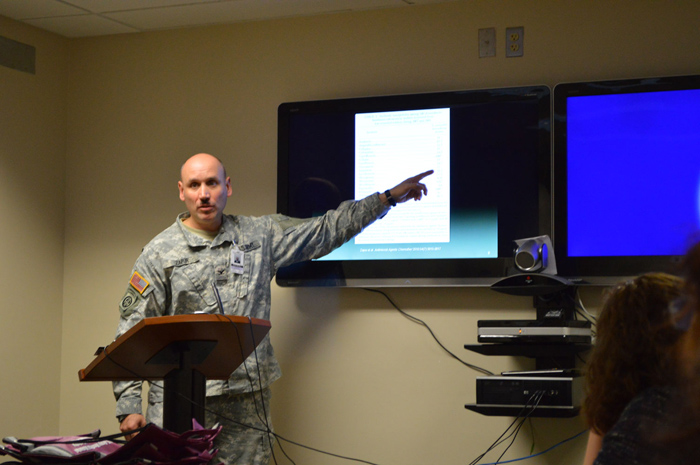Arbekacin As an Antibiotic To Treat Service Members

What happens when antibiotics cannot cure an infection?
This is the issue being studied by the U.S. Army Medical Materiel Development Activity (USAMMDA) at the Walter Reed National Military Medical Center (WRNMMC), where injured Service Members go for battlefield injury treatment.
As the face of war is ever-changing, so are the needs of the Service Members. During the most recent conflicts in Afghanistan and Iraq, we have seen multi-drug resistance (MDR) to bacterial organisms that previously did not exist. Due to this resistance, it has become more difficult to cure various infections. The USAMMDA has been working to develop Arbekacin as an antibiotic treatment for infections caused by MDR bacteria, to give our Service Members relief from prolonged injury.
The Force Health Protection-Investigational New Drug Division (FHP-IND) of USAMMDA has been working on this Arbekacin project since May 2010. Christa Madock, Chief of the Surveillance Branch, FHP-IND, has been working on this project since the beginning, well before its official addition to the FHP-IND portfolio. "FHP-IND is uniquely qualified to make IND products available to Service Members. Since research in 2008 demonstrated Arbekacin's in vivo (in the lab) efficacy, USAMMDA FHP-IND was selected as the vehicle for making this drug more rapidly available to wounded warriors.", stated Madock.
Arbekacin was first introduced in Japan by Meiji Seika Pharma Co., LTC, in 1990 under the trade name Habekacin, for the treatment of pneumonia and septicemia caused by MRSA. Meiji Seika Pharma Co., LTC is working in collaboration with USAMMDA, to provide the Arbekacin being used in this study.
Col. Michael Zapor, MD, PhD, Infectious Disease Service at WRNMMC, will be the Principal Investigator for the study. As such, Zapor will be the treating physician to the wounded warriors seeking MDR infection treatment at WRNMMC.
Zapor explained, "The emergence of antibiotic resistance is an evolutionary phenomenon and attests to the tremendous adaptability of bacteria. For example, in the 1950s, penicillin was a potent antibiotic against Staphylococcus aureus. Now, it is very uncommon to isolate a penicillin susceptible Staphylococcus. The use of antibiotics doesn't eradicate bacteria, it simply inhibits or kills bacteria that are not innately resistant or haven't acquired resistance to the antibiotic."
In a summary statement to the US Congress, the Infectious Diseases Society of America recognized antimicrobial resistance as "one of the greatest threats to human health worldwide".
The individual with MDR is not resistant to antibiotics themselves, as we would believe, but it is the infecting organism in the individual that is resistant to antibiotic. This resistance is caused by several factors, unavailability, intolerance, contraindications, or treatment non-response.
"Since the beginning of the Global War on Terror, treatment of a patient with an infection caused by a MDR bacterium has been one of the commonest causes for an infectious diseases consultation in our hospital. In many instances, the infecting organism was only susceptible to one, perhaps two, of the many antibiotics tested; and in a few instances, we have seen pan-resistant isolates, meaning resistance to all antibiotics tested. Management of these infections poses a daunting challenge for the infectious diseases physician, and I envision this being a potential role for Arbekacin." stated Zapor.
This study will seek enrollment of 50 patients, up to five years in duration, to be treated at WRANMMC. Each patient will be determined to have a bacterial infection, of MDR bacteria. Under this treatment protocol, inclusion criteria include infections of the respiratory tract, bloodstream, skin, soft tissue, bone and/or genitourinary tract. Patients will be given daily dose intravenous Arbekacin for 3-14 days (most infections). Efficacy will be measured by clinical or microbiologic cure of the infection.
Additional collaborators in this study include Walter Reed Army Institute of Research, Johns Hopkins Medical Institution, and Uniformed Services University of the Health Sciences. When certain drugs used to cure infection, prove to be ineffective, there must be another solution. This is why so many organizations are partnered to make Arbekacin available to treat these infections that might have otherwise gone untreated.
Zapor explained, "Arbekacin is not a silver bullet and I fully expect that it will prove beneficial in only very specific situations. I also expect to see the emergence of resistance with its use. History has shown this to be the case with all antibiotics.
However, Arbekacin will provide a therapeutic option for some patients with infections caused by MDR bacteria for which other antibiotics have failed or cannot be used. Moreover, approval and implementation of the Arbekacin human use protocol is a striking example of a clinical question or problem leading to basic research and culminating in a product with a clinical application. Additionally, this treatment protocol illustrates the potential benefit to be gained when clinicians, scientists and regulatory personnel collaborate on achieving a common goal."
Zapor is an advocate for the future of medicine and medical research. The ability to use Arbekacin in the future will benefit generations of wounded warriors for the future.
This study will begin in April 2013.














